AMD FX-8320E CPU Review: The Other 95W Vishera
by Ian Cutress on January 13, 2015 10:00 AM ESTF1 2013
First up is F1 2013 by Codemasters. I am a big Formula 1 fan in my spare time, and nothing makes me happier than carving up the field in a Caterham, waving to the Red Bulls as I drive by (because I play on easy and take shortcuts). F1 2013 uses the EGO Engine, and like other Codemasters games ends up being very playable on old hardware quite easily. In order to beef up the benchmark a bit, we devised the following scenario for the benchmark mode: one lap of Spa-Francorchamps in the heavy wet, the benchmark follows Jenson Button in the McLaren who starts on the grid in 22nd place, with the field made up of 11 Williams cars, 5 Marussia and 5 Caterham in that order. This puts emphasis on the CPU to handle the AI in the wet, and allows for a good amount of overtaking during the automated benchmark. We test at 1920x1080 on Ultra graphical settings.
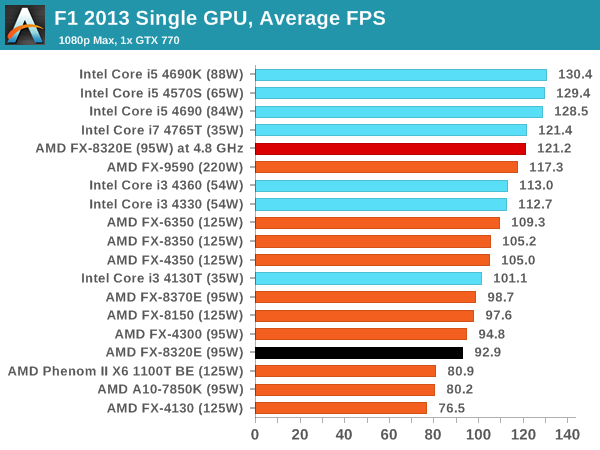
In both single and dual GPU cases, the stock performance of the FX-8320E falls behind the i3 CPUs by a 10-20 FPS margin, perhaps being noticeable on 120 Hz monitors. The minimum FPS on a single GPU still retains above 60 FPS, which is a plus.
Bioshock Infinite
Bioshock Infinite was Zero Punctuation’s Game of the Year for 2013, uses the Unreal Engine 3, and is designed to scale with both cores and graphical prowess. We test the benchmark using the Adrenaline benchmark tool and the Xtreme (1920x1080, Maximum) performance setting, noting down the average frame rates and the minimum frame rates.
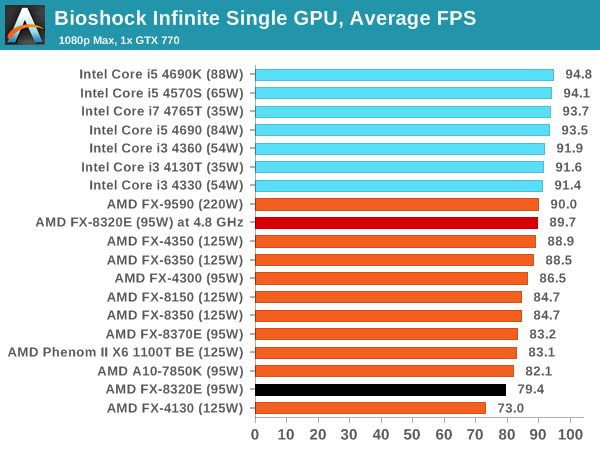
While average frame rates almost appear to be CPU agnostic, there is a clear AMD/Intel split here. More interesting is the minimum FPS results which seem to rely on IPC.
Tomb Raider
The next benchmark in our test is Tomb Raider. Tomb Raider is an AMD optimized game, lauded for its use of TressFX creating dynamic hair to increase the immersion in game. Tomb Raider uses a modified version of the Crystal Engine, and enjoys raw horsepower. We test the benchmark using the Adrenaline benchmark tool and the Xtreme (1920x1080, Maximum) performance setting, noting down the average frame rates and the minimum frame rates.
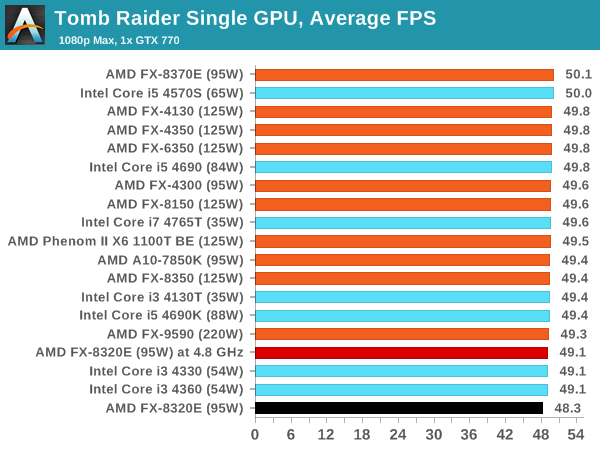
Tomb Raider still comes across as purely CPU agnostic.
Sleeping Dogs
Sleeping Dogs is a benchmarking wet dream – a highly complex benchmark that can bring the toughest setup and high resolutions down into single figures. Having an extreme SSAO setting can do that, but at the right settings Sleeping Dogs is highly playable and enjoyable. We run the basic benchmark program laid out in the Adrenaline benchmark tool, and the Xtreme (1920x1080, Maximum) performance setting, noting down the average frame rates and the minimum frame rates.
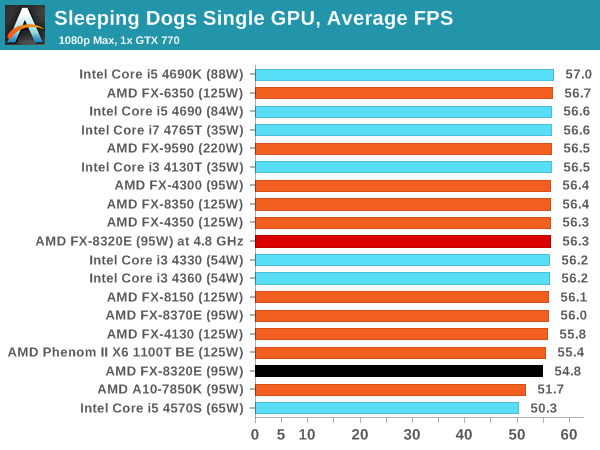
Single GPU usage puts the 8320E in the ballpark, but moving to dual GPUs sees an uplift in terms of the i5 CPUs for high refresh rate screens, albeit with the extra cost associated.
Battlefield 4
The EA/DICE series that has taken countless hours of my life away is back for another iteration, using the Frostbite 3 engine. AMD is also piling its resources into BF4 with the new Mantle API for developers, designed to cut the time required for the CPU to dispatch commands to the graphical sub-system. For our test we use the in-game benchmarking tools and record the frame time for the first ~70 seconds of the Tashgar single player mission, which is an on-rails generation of and rendering of objects and textures. We test at 1920x1080 at Ultra settings.
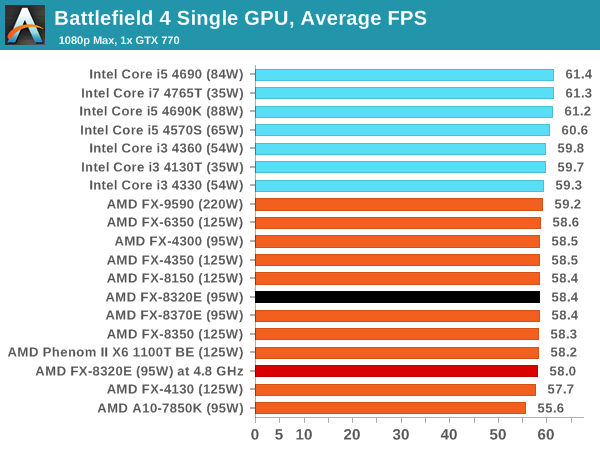
Single GPU shows little difference (despite a clear AMD/Intel separation line), but in dual GPU mode an i3 will make a 17 FPS rise, moving to 27 FPS with the i5 and more relevant to high refresh displays.















92 Comments
View All Comments
ExarKun333 - Tuesday, January 13, 2015 - link
Yeah, who needs PCIe 3.0, M.2 drives, etc? LOLroyalcrown - Tuesday, January 13, 2015 - link
M.2 is kind of dumb, stuff should just hurry up and migrate to pcieYukaKun - Tuesday, January 13, 2015 - link
You're not serious, right?The only real thing that the 990FX chipset needs is more USB3 ports and that's about it. I don't remember if the NB needs "DDR4 support" of some kind. Maybe extra interconnect logic.
PCIe 3.0 is not relevant right now since PCIe 2.0 is still enough. And not even with 3 or 4 cards in tandem, PCIe 3.0 is justifiable as a "required feature". M.2 drives... I don't even know why it is something you'd want in a desktop PC.
Cheers!
postem - Tuesday, January 13, 2015 - link
All while z97 chipset forces you to scale down PCI for every device you plug in.Intel forces chipset/socket every 2 years to force you buy new motherboards, its part of their game with their partners.
I really wish to go back to AMD, but ATM there is really not a reasonable performance cpu on their line and i really doubt will be any on foresee future.
Samus - Tuesday, January 13, 2015 - link
Intel actually launched the 90-series chipset 9 months after the 80-series. Granted, all rev C0 and newer 80-series run any CPU the 90-series does, but a lot of first adopters of the H81/H87/Z87 got screwed into no upgrade path.I agree, M2 in the desktop makes zero sense, and PCIe 3.0 is useless and will be for years. Most GPU's don't even utilize the full bandwidth of PCIe 2.0 8x.
As I said, Intel could think a little more forward (they're capable of doing so) but I think the marketing and bureaucratic politics are making the engineers push chipsets like there's no tomorrow. Intel actually makes as much selling chipsets as they do selling entry-level CPU's.
hojnikb - Tuesday, January 13, 2015 - link
>The only real thing that the 990FX chipset needs is more USB3 ports and that's about it. I don't remember if the NB needs "DDR4 support" of some kind. Maybe extra interconnect logic.Not more. 990FX doesn't even have any kind of native usb3 at all. All you see is 3rd party support via asmedia or similar chips.
So yeah, amd needs native usb3 and pcie 3.0 on their chipsets.
silverblue - Tuesday, January 13, 2015 - link
Assuming there's demand, AMD should look producing the 970 in 32nm (GF must have some spare capacity, surely?). Throw in native USB3 and halve chipset power consumption all at the same time. A 970A, if you will.hojnikb - Tuesday, January 13, 2015 - link
they never gonna do that.III-V - Tuesday, January 13, 2015 - link
>PCIe 3.0 is not relevant right now since PCIe 2.0 is still enough. And not even with 3 or 4 cards in tandem, PCIe 3.0 is justifiable as a "required feature". M.2 drives... I don't even know why it is something you'd want in a desktop PC.Lol, no matter how many times this argument gets defeated, it still pops up.
GPUs are not the only devices that utilize PCIe. Case in point: SSDs.
Cryio - Wednesday, January 14, 2015 - link
PCIe 2.0 still isn't getting maxed out. You are loosing ... 3% of performance by not going with PCIe 3.0. A lot of people don't even know what M.2 drives are.We only need proper USB 3.0 implementation. Current 970/990 chips have USB 3.0, but they're not native and not as fast.